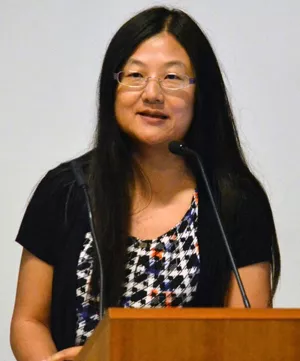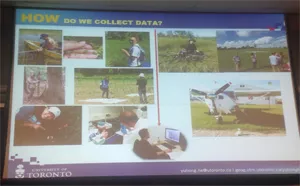
Lab Liaisons Celebrates 5 Years!
Though the format might have changed somewhat, the engagement stayed the same.
This year the Research Office’s Lab Liaisons event diverged from its typical focus for highlighting research in one single department and instead identified the theme of earth science and ecology for a “Dishing the Dirt” session. Professors Ingo Ensminger from Biology, Yuhong He from Geography and Marc Laflamme from Chemical & Physical Sciences certainly delivered.
With a captivated audience made up of faculty and staff from several different departments, their respective talks touched on climate change, trees, Emerald ash borer beetles, remote sensing, fossils, worm poop, and maggots.
“Most species that have ever lived on earth are now extinct,” began Professor Marc Laflamme with a quote in his presentation about his work in soft-tissue fossilization and paleontology, which takes him to a variety of places such as Newfoundland, South Australia and Namibia, as well as his newly renovated UTM lab, to conduct his research. “The only evidence that we have of their existence is trapped in the fossil record, and it’s our job as paleontologists to decipher as much information as we can about the biology, about the environment, about this ancient world based on our understanding of these fossils.”
Laflamme focuses on soft-body fossilization of organisms, particularly of the Ediacaran biota, which is fauna from approximately 578 million years ago, and even replicates the conditions required for fossilization to occur in his lab using a dish, some of the Ediacaran organisms they have collected and processed, and some maggots to preserve the soft tissue of the larvae. This provided perhaps the most squeamish moments of the event, particularly when Laflamme said that the smell this used to give off in his lab, before he had a special case built and installed, was pungent enough to keep colleagues and friends away.
Trees and climate change factored prominently in both the talks given by Professors Ingo Ensminger and Yuhong He, though the former is working in Biology and the latter is in Geography. Ensminger is an expert in plant physiology and climate change, and the response of trees and forest ecosystems to warmer and drier climates, while He uses remote-sensing techniques and spatial analysis and data to observe changes and environmental factors such as climate and oil and gas exploration.
Ensminger emphasized the work he is doing in the lab, at various field sites and growth chambers, and, coming soon, the green houses that have recently been built on campus for research. As part of his presentation, he showed a visual animation of the global temperature anomalies since 1880 to 2014 to demonstrate the reality of C02, its warming effect and the resulting climate change.
“This is not a prediction or anything made up by scientists, this is observed and measured data,” said Ensminger, as the audience watched a map change in colour so it was mostly all yellow and orange towards the end of the observations indicating an increase in temperature above the average normally observed.
“You can see that over time, more often, more frequent, and over much, much larger areas, we see these temperature increases.” (The animation can be viewed here https://svs.gsfc.nasa.gov/cgi-bin/details.cgi?aid=4252.)
Climate change is also a focus for Professor He, and this hits a bit closer to home as she has been preoccupied with the flooding taking place in her hometown in China over the past few days. She emphasized, as did Ensminger, that climate change is a very real occurrence that we can see evidence of on a daily basis.

“We use remote sensing to accurately map and evaluate ecosystems and trees, such as species, structure and function across space and over time, pretty much anything on earth, we can get a map for you,” said He, who started out studying grasslands in Saskatchewan as part of her PhD.
“I have also studied forested areas in Alberta that are undergoing serious human activities mainly related to oil exploration.”
All three presenters made their work very accessible, which is part of the intention of Lab Liaisons, now celebrating its fifth year of bringing a behind-the-scenes look at UTM research to interested audience members. The event started out as a way to bridge the disconnect between researchers and those on campus who help to make the labs, facilities and chambers run most efficiently, and it has become a great way to celebrate the fascinating and wide-ranging work being done on this campus.
Stay tuned for the next year’s installment!
